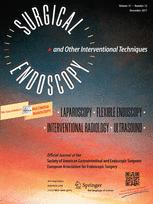Bell RC, Freeman KD
Surg Endosc. 2011 Jun; 25(6):1975-84.
BACKGROUND:
Transoral treatment of gastroesophageal reflux disease (GERD) using the EsophyX device enables creation of an esophagogastric fundoplication with potential for better control of reflux than gastrogastric techniques. Efficacy and safety of a rotational/longitudinal esophagogastric transoral incisionless fundoplication (TIF) was evaluated retrospectively using subjective and objective outcomes.
METHODS:
Thirty-seven consecutive patients on antisecretory medication and with proven gastroesophageal reflux and limited hiatal hernia underwent TIF for persistent GERD symptoms. Five patients were reoperations for failed laparoscopic fundoplication.
RESULTS:
Of the 37 treated patients, 57% were female. The median age was 58 (range=20-81) years and BMI was 25.5 (range=15.9-36.1) kg/m2. Sixty-eight percent indicated GERD-associated cough, asthma, or aspiration as a primary complaint and 32% complained of heartburn or regurgitation. The TIF procedures created tight wraps of 230°-330° extending 3-4 cm above the Z-line. Two complications occurred: one mediastinal abscess treated laparoscopically and one postoperative bleeding requiring transfusion. At 6 (range=3-14) months median follow-up TIF resulted in a significant improvement of both atypical and typical symptoms in 64% and 70-80% of patients, respectively, as indicated by the corresponding GERD health-related quality of life (HRQL) and reflux symptom index (RSI) score reduction by 50% or more compared to baseline on proton pump inhibitors (PPIs). No patient reported problems with dysphagia, bloating, or excess flatulence, and 82% were not taking any PPIs. Reflux characteristics were significantly improved and normalized in 61, 89, and 56% of patients in terms of acid exposure, number of refluxates, and DeMeester scores, respectively. TIF was effective in treating GERD in 75% of patients among whom 54% were in a complete “remission” and 21% were “improved.” The remaining 25% were considered failures, and five (13.5%) patients underwent revision.
CONCLUSION:
Rotational/longitudinal esophagogastric fundoplication using the EsophyX device significantly improved symptomatic and objective outcomes in over 70% of patients at median 6-month follow-up. Post-fundoplication side effects were not reported after TIF.
Link to open access article: Bell RC, et al; Surg Endosc. 2011 Jun; 25(6):1975-84.


